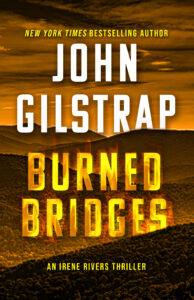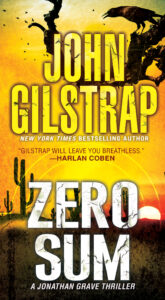By John Gilstrap
By way of full disclosure, I don’t often participate in our First Page Critique program. It’s not that I don’t think there’s value in it, but rather that I don’t think I’m particularly qualified to critique the work of others. As I’ve mentioned here about a bazillion times, I am entirely self-taught. By sheer trial and error, I’ve learned what works for me, and what irks me about the works of others. The problem is that I am often irked by some of the bestselling authors on the planet, which brings me back to what the hell do I know? And who am I to presume to tell others what to do?
On the rare occasions when I do pick up a sample for a first page critique, it’s because I think the work has a lot of potential, and it falls within areas of my expertise where I know I can provide some wisdom that goes beyond the mechanics of writing. Today’s sample of Smooth Operator, by Courageous Author Unknown, is just such an example. (Note to said author: if you email john@johngilstrap.com, I’ll send you the complete marked-up manuscript.)
Here we go. First the original manuscript in bold font, with my comments on the back end:
Smooth Operator
Chapter 1
“Give yourself up, Ma’am,” the agent shouted. “There is no way out. It’s your only choice.”
Madam Chiang hunkered low against the grey BMW, still clutching the empty Beretta in her perfectly manicured hands.
Oh please. You sound like some B-grade cop movie.
“You only have one option,” the agent shouted again. “Give up now and I won’t shoot. Back-up’s on the way.”
Ah, rookies. It’s Sunday evening. Any back-up is still twenty miles away. And, of course I have options. I always have options. She just hadn’t thought of one yet.
But, in that exchange, Madam Chiang had gained two valuable pieces of information. First, she knew the agent had no idea who she was pursuing, because she had been addressed as ma’am. Likely, the agent only assumed she was a threat because she had just witnessed Madam Chiang blow her friend to oblivion. Not an altogether bad assumption.
Second, the agent was most likely not even on duty. Her tight dress and heels said she wasn’t here for work. Probably only stopped by the office on her way to a party. Whatever the reason, it must have been dumb luck that the agent saw her at all.
Moments ago, Madam Chiang had been inside the federal building rushing toward her prearranged exit, clutching the recovered evidence against her chest. She had just spotted her door when a chime announced the elevator’s arrival. Startled, she turned toward the sound. Two women stepped half way out before glimpsing Madam Chiang. All three froze simultaneously. Madam Chiang noticed their eyes widen as they spotted the pistol in her hand. Were they just harmless visitors or a threat?
That question was quickly resolved when one of the women popped open her clutch and pulled out her own pistol. Madam Chiang leveled the Beretta and squeezed off two rounds. Her first hollow-point hit its mark, entering the body just below the unarmed girl’s armpit, continuing on to obliterate her heart and lungs. The force slammed her body into a wall before folding to the floor in a crumpled heap. The second slug missed its mark.
The surviving agent jerked back inside the elevator firing an errant shot as she did. A split-second later, Madam Chiang fired one final shot toward the open elevator and sprinted toward her exit, charging toward cover in an adjacent parking structure.
It’s Gilstrap again. Pretty good stuff overall, don’t you think? The piece certainly starts on action. We get some good hints of attitude in the narration surrounding Madam Chiang. To be sure, she’s not a lady I want to cross when she’s cranky. Let’s stipulate that Courageous Unknown Author knows what s/he’s doing, and that this snippet earns a solid B. Now let’s get to the business of making a good thing even better:
“Give yourself up, Ma’am,” the agent shouted. “There is no way out. It’s your only choice.”
Given what we learn later–that our POV character has killed the agent’s friend–this dialogue prints as way too polite to me. “Show yourself or I will effing kill you!” (or something along those lines, depending on your market) seems way more appropriate. Also, where is the agent relative to our character? Shouldn’t our character be worried about the agent moving for position, especially since her weapon is dry?
Madam Chiang hunkered low against the grey BMW, still clutching the empty Beretta in her perfectly manicured hands.
There are dozens of models of Berettas, but one thing they all have in common is the fact if the magazine is empty, there’s been a hell of a gunfight. I don’t buy that a) she’d be noticing her manicure, or b) that she wouldn’t have broken a nail or gotten them dirty in a running gunfight. The gunshot residue alone would have dirtied her hands.
Also–and this is one of my proprietary irks–please name your characters, especially for close in 3rd POV. First of all, Madam Chiang reads to me as someone who runs a brothel. Later, as the action picks up, you seem to realize that the name is awkward, and resort instead into battling pronouns.
Oh please. You sound like some B-grade cop movie.
Attach this to the end of the paragraph above. That way, it’s easier to know whose thoughts we’re reading. As for the substance of the thought, I was thinking the same thing, but not in a good way.
“You only have one option,” the agent shouted again. “Give up now and I won’t shoot. Back-up’s on the way.”
Let’s think about this. I’m the agent and you’re the bad guy that I’ve got dead to rights on a murder charge. Why would I think for a minute that you would give yourself up after a gunfight? Why would I be marking my position with my voice so you would know where I am–especially since I’m alone? In this circumstance, if I knew where you were, I’d be advancing on your position as silently as I could to take you out. If I didn’t know where you were, I’d take cover somewhere and not make a sound while I waited for you to make a move and show yourself. If you were a professional–and that seems to be what you’re making Madam Chiang out to be–you would know all of this and you’d be plotting accordingly.
Ah, rookies. It’s Sunday evening. Any back-up is still twenty miles away. And, of course I have options. I always have options. She just hadn’t thought of one yet.
Proprietary irk #2: I hate long passages of quoted thought, because that’s not really how we think. At least, that’s not how I think. If this were my story, I would initiate the thought with italics, and then move on with close-in 3rd person narration. Like this:
Ah, rookies. It was Sunday evening, any backup was still twenty minutes away, and she always had options. She just hadn’t thought of one yet. (By the way, I really like that last sentence.)
Now, let’s talk about the choreography. Are federal buildings–the setting, as we will learn in the next section–ever so empty that backup is twenty minutes away? I’m thinking more like 90 seconds.
But, in that exchange, Madam Chiang had gained two valuable pieces of information. First, she knew the agent had no idea who she was pursuing, because she had been addressed as ma’am. Likely, the agent only assumed she was a threat because she had just witnessed Madam Chiang blow her friend to oblivion. Not an altogether bad assumption.
This is the only paragraph in the sample that I hate in its entirety. The glibness just doesn’t work. And it stops the flow of the story.
Second, the agent was most likely not even on duty. Her tight dress and heels said she wasn’t here for work. Probably only stopped by the office on her way to a party. Whatever the reason, it must have been dumb luck that the agent saw her at all.
The detail of the agent’s dress (how do we know she’s an agent, by the way, and not a security guard or concealed carrier?) may pay off later, but if not, this is a bit of a non sequitur for me.
Then, there’s a space break, and . .
Moments ago, Madam Chiang had been inside the federal building rushing toward her prearranged exit, clutching the recovered evidence against her chest. She had just spotted her door when a chime announced the elevator’s arrival. Startled, she turned toward the sound. Two women stepped half way out before glimpsing Madam Chiang. All three froze simultaneously. Madam Chiang noticed their eyes widen as they spotted the pistol in her hand. Were they just harmless visitors or a threat?
First, I don’t understand why this is not the beginning of the story.
I’m not at all oriented to the setting here. I know it’s a federal building, but that doesn’t mean anything. The federal building here in Martinsburg, WV, is entirely different than the federal building in Washington, DC. Are we talking marble floors? Artwork on the walls?
And where are the security guards?
“Prearranged exit” implies additional players. Either way, don’t be coy. Share with us what that exit is and how far away it is.
At this stage, I don’t think we need to know what the “recovered evidence” is, but I’m curious why she’s walking the halls with her pistol drawn if she’s just stealing stuff. A gun in your hand makes it more difficult to clutch things against your chest. Also, the reaction of the ladies in the elevator when they see the gun is exactly the reason not to have one in her hand unless she’s on the attack.
That question was quickly resolved when one of the women popped open her clutch and pulled out her own pistol. Madam Chiang leveled the Beretta and squeezed off two rounds. Her first hollow-point hit its mark, entering the body just below the unarmed girl’s armpit, continuing on to obliterate her heart and lungs. The force slammed her body into a wall before folding to the floor in a crumpled heap. The second slug missed its mark.
Here’s a rule to live by–literally: Never draw down on a drawn gun because you’re going to lose the fight. Agents know this. When the gun is carried off-body (as in a purse), it’s an even bigger problem. The agent’s smart move would have been to duck back into the elevator for cover and to buy a few seconds of time.
Okay, I’m an armed bad guy and I confront two targets–one is armed and one is not. Why on earth would I shoot the unarmed target first? We know it wasn’t a miss because the bullet “hit its mark.”
Is Madam Chiang still clutching the evidence to her chest when she fires these shots? If she’s a professional, she needs to finish this gunfight right here. Drop the evidence, engage the targets and be done with it. To intentionally leave an armed and angry enemy alive to follow as you run is a bad decision.
Proprietary irk #3: Bullets don’t throw people around when they hit. Also, while you can see where a bullet hits on a person’s body, there’s no way to know in real time where it goes as it tumbles through the viscera.
If Madam Chiang is a professional, she would know exactly where that second bullet landed, and she would be pissed.
The surviving agent jerked back inside the elevator firing an errant shot as she did. A split-second later, Madam Chiang fired one final shot toward the open elevator and sprinted toward her exit, charging toward cover in an adjacent parking structure.
The smart move for Madam Chiang would be to dump half a magazine through the elevator door behind which the agent was hiding, and then move to the opening to make sure the job was done.
Before the beginning to this paragraph, this post was at 2,048 words. Probably time to move on.
I hand it over to the rest of the TKZ family for further analysis . . .

 I’ve posted before about our beloved dog Kimber, a mix of Cavalier King Charles Spaniel and Boston Terrier called a Caviston. (And yes, it bothers me that it’s not spelled Cavaston, but no one consulted me.) When we first moved to the woodland house in West Virginia, she weighed less than five pounds and I was keenly aware that the entire world posed one big hazard for her. Not only was she prey to most other creatures, her girth was smaller than that of the floor vents which hadn’t yet been covered.
I’ve posted before about our beloved dog Kimber, a mix of Cavalier King Charles Spaniel and Boston Terrier called a Caviston. (And yes, it bothers me that it’s not spelled Cavaston, but no one consulted me.) When we first moved to the woodland house in West Virginia, she weighed less than five pounds and I was keenly aware that the entire world posed one big hazard for her. Not only was she prey to most other creatures, her girth was smaller than that of the floor vents which hadn’t yet been covered. Once permitted to wander her fenced domain alone during the day, she turned into quite the squirrel hunter, chasing them great distances until the critters cheated and shot up a tree. I don’t think Kimber ever figured out why she couldn’t follow. She’s an avid deer chaser, too, though I’m not sure of her plan for when she caught one.
Once permitted to wander her fenced domain alone during the day, she turned into quite the squirrel hunter, chasing them great distances until the critters cheated and shot up a tree. I don’t think Kimber ever figured out why she couldn’t follow. She’s an avid deer chaser, too, though I’m not sure of her plan for when she caught one. Last week was reasonably cool for a June afternoon, so we left the downstairs door open to allow Kimber to come and go as she pleased to and from the back yard. My office sits on the second floor, overlooking the backyard and the woods beyond. I was doing as I always do while staring down the maw of an approaching deadline, pounding away on the keyboard, playing with my imaginary friends when a cacophony erupted from out beyond my windows.
Last week was reasonably cool for a June afternoon, so we left the downstairs door open to allow Kimber to come and go as she pleased to and from the back yard. My office sits on the second floor, overlooking the backyard and the woods beyond. I was doing as I always do while staring down the maw of an approaching deadline, pounding away on the keyboard, playing with my imaginary friends when a cacophony erupted from out beyond my windows. The book on the X at the moment is Burned Bridges (Spring/Summer, 2025), the first installment of my new series featuring Irene Rivers, the FBI Director from the Jonathan Grave series. The very existence of the series is a bit of a spoiler for the next Grave book,
The book on the X at the moment is Burned Bridges (Spring/Summer, 2025), the first installment of my new series featuring Irene Rivers, the FBI Director from the Jonathan Grave series. The very existence of the series is a bit of a spoiler for the next Grave book,  Also, the Irene Rivers series will not be Jonathan Grave with a female protagonist. This series will be more subtle. Less explosive. Driven out of Washington by the political implosion she caused, she’s living out in the country now on inherited family land, trying to reconnect with her kids and be as invisible as possible. To give herself a little something to do, she hangs out her shingle as a private investigator.
Also, the Irene Rivers series will not be Jonathan Grave with a female protagonist. This series will be more subtle. Less explosive. Driven out of Washington by the political implosion she caused, she’s living out in the country now on inherited family land, trying to reconnect with her kids and be as invisible as possible. To give herself a little something to do, she hangs out her shingle as a private investigator. When I teach master classes–as I will be in September at the
When I teach master classes–as I will be in September at the 




